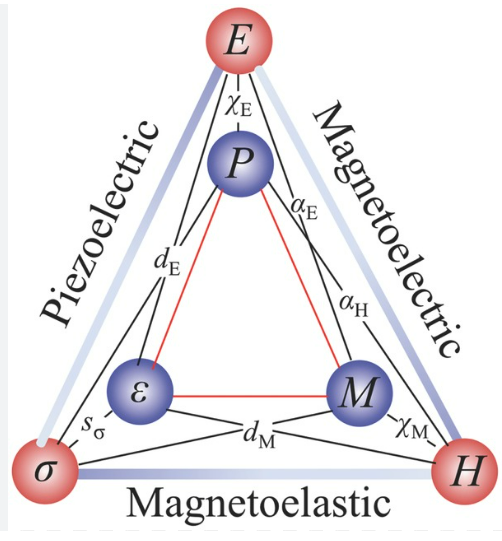Introduction:
What is multi-ferroelectric material?
A multi-ferroic material is a type of material that exhibits multiple types of ferroic ordering, such as ferromagnetism, ferroelectricity, and ferro-elasticity, in a single material. In other words, these materials can have more than one ferroic property simultaneously.
Ferroic materials are characterized by the existence of a spontaneous polarization or magnetization, which can be switched or reversed by an applied electric or magnetic field, respectively. Ferromagnetic materials, for example, exhibit a spontaneous magnetization, while ferroelectric materials exhibit a spontaneous electric polarization. Ferroelastic materials exhibit a spontaneous deformation or strain.
Multi-ferroic materials are of great interest because they offer the potential for new types of functional materials and devices, such as magnetoelectric sensors, actuators, and memory devices. For example, a magnetoelectric memory device could store data as both magnetic and electric signals, which could provide enhanced performance and energy efficiency compared to traditional memory technologies. How they are connected each other is shown in figure 1.
Some examples of multi-ferroic materials include bismuth ferrite (BiFeO3), which exhibits both ferroelectric and antiferromagnetic orderings, and lead magnesium niobate-lead titanate (PMN-PT), which exhibits both ferroelectric and ferroelastic orderings. Research is ongoing to explore new types of multi-ferroic materials and to understand the underlying physics that govern their behavior.
Ferroic in one materials?
materials can have both ferromagnetic and ferroelectric characteristics, and such materials are called "magnetoelectric multiferroics." These materials exhibit both magnetic and electric polarizations that are coupled to each other, allowing for control of one property with the other. The coupling between magnetic and electric polarizations in these materials can be exploited for various applications, including magnetoelectric sensors, actuators, and memory devices.
One example of a magnetoelectric multiferroic material is bismuth ferrite (BiFeO3), which exhibits both ferroelectric and antiferromagnetic orderings. Another example is TbMnO3, which exhibits ferromagnetism and ferroelectricity at low temperatures.
Magnetoelectric multiferroics are still an area of active research, and many challenges remain in developing practical devices based on these materials. One challenge is to optimize the coupling between the magnetic and electric polarizations, as this coupling can be weak in some materials. Another challenge is to develop methods for integrating these materials into practical devices with high performance and reliability. However, the potential applications of magnetoelectric multiferroics make them an exciting area of research with significant potential for technological innovation.
Device target and concepts:
Multi-ferroic materials are materials that exhibit both ferromagnetic and ferroelectric properties simultaneously. In other words, these materials possess magnetic and electric ordering that can be controlled by each other. The device concept of multi-ferroic materials involves the development of devices that exploit the unique properties of these materials for various applications.
One such application is in data storage devices, where multi-ferroic materials can be used to develop non-volatile memories. The electric field can be used to control the magnetic state of the material, leading to the possibility of developing magnetic random access memory (MRAM) devices with low power consumption and high speed and vice versa. Figure 2 shows a conceptual device with multiferroic concept.
Another potential application is in sensors and actuators. Multi-ferroic materials can be used to develop sensors that can detect both magnetic and electric fields simultaneously, which can have applications in medical imaging and non-destructive testing. Additionally, multi-ferroic materials can also be used to develop actuators that can be controlled using either magnetic or electric fields, which can be useful in the development of microelectromechanical systems (MEMS).
Overall, the device concept of multi-ferroic materials has significant potential for various applications, including data storage, sensing, and actuation, and ongoing research in this area is expected to lead to the development of new and innovative devices.
Major challenges:
There are several major challenges associated with magnetoelectric multiferroic materials that are currently being addressed by researchers in the field. Some of these challenges include:
Finding new materials: Currently, there are only a limited number of materials that exhibit both ferromagnetic and ferroelectric properties, and most of these materials have low magnetoelectric coupling. Thus, one major challenge is to find new materials that exhibit strong magnetoelectric coupling and are suitable for practical applications.
Understanding the underlying physics: The physics of magnetoelectric coupling is still not well understood, and more research is needed to understand the mechanisms that govern the coupling between magnetic and electric properties.
Developing practical devices: Magnetoelectric multiferroic materials have the potential to enable new types of devices, such as magnetoelectric sensors, actuators, and memory devices. However, there are still significant challenges associated with developing practical devices based on these materials, such as achieving high sensitivity, reliability, and manufacturability.
Controlling domain structure: The domain structure of magnetoelectric multiferroic materials can have a significant impact on their properties and performance. However, controlling the domain structure of these materials is a significant challenge, and more research is needed to develop effective methods for controlling domain structure at the nanoscale.
Temperature effect: Temperature can have a significant effect on the properties of magnetoelectric multiferroic materials. The ferromagnetic and ferroelectric properties of these materials are often strongly coupled, and changes
Overall, magnetoelectric multiferroic materials are a promising area of research, but there are still many challenges that must be addressed before they can be effectively integrated into practical devices. Please find other fruitful discussion here.


No comments:
Post a Comment